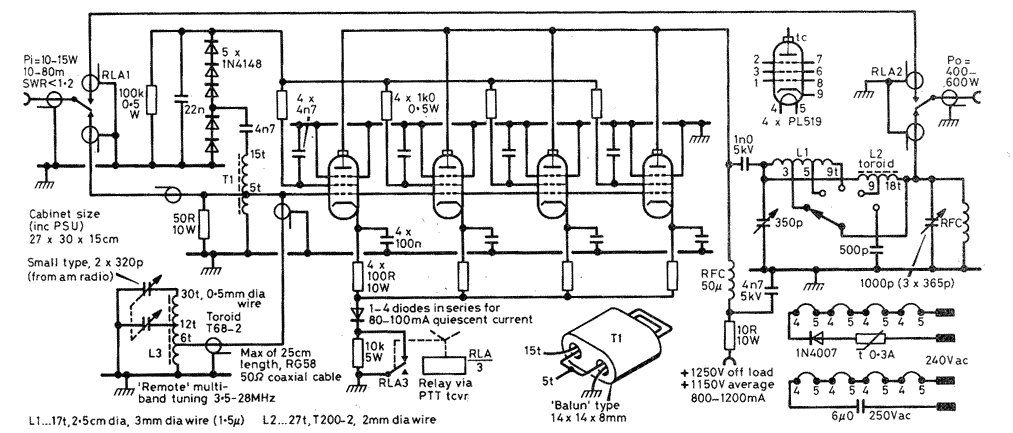|
||||||
A passive-grid 400W linear HF amplifier
RSGB Handbook 8th edition.

Fig 5.75. A passive-grid 400W linear HF amplifier, the PAOFRI Frinear. Screen-grid voltage is derived from the RF input and no grid bias supply is required
PAOFRI's Frinear-400 is shown in Fig 5.75 [29]. It has several interesting features. • Being a passive-grid amplifier, most of the input power is dissipated in a hefty carbon resistor. The voltage across it is applied to the control-grids of the valves and, considering the low value of the resistor (50 or 68 Ohm), one might expect this arrangement to be frequency-independent; however, the capacitances of the four grids, sockets and associated wiring add up to about 100pF which is only 55 Ohm at 29MHz! This capacitance must be tuned out if what is adequate drive on 3.5MHz is to produce full output on the higher-frequency bands. PAOFRI does this with a dual-resonant circuit (L3 and ganged tuning capacitors) similar to the well-known E-Z-Match antenna tuner; it covers 3.5-29MHz without switching. • The screen grids in this amplifier are neither at a fixed high voltage nor at earth potential but at a voltage which is proportional to the RF drive. To that end, the RF input is transformed up 3: 1 in T1, rectified in a voltage doubler and applied to the four bypassed screen grids through individual resistors. This method is consistent with good linearity. • Control-grid bias is not taken from a mains-derived negative supply voltage but the desired effect, reducing the standing current to 20-25 mA per valve, is obtained by raising the cathodes above earth potential. The bias voltage is developed by passing each cathode current through an individual 100 Ohm resistor and the combined currents through as many forward-biased rectifier diodes as are required to achieve a total standing current of 80-100mA. The individual cathode resistors help in equalising the currents in the four valves. During non-transmit periods the third contact set (RLA3) on the antenna changeover relay opens and inserts a large (10 kOhm) resistor into the combined cathode current, which thereby is reduced to a very low value. • The pi-filter coil for 3.5 and 7MHz is wound on a powdered-iron toroid which is much smaller than the usual air-core coil. This is not often seen in high-powered amplifiers due to the fear that the large circulating current might saturate the core and spoil the intermodulation performance but no distortion was discernible in a two-tone test. • In Fig5.75, the 42V filaments of the four valves and a capacitor are shown series connected to the 240V mains. This 0.3A chain is the way these valves were intended to be used in CTV sets and it does save a filament transformer, but this method is not recommended for experimental apparatus such as a home construction project. Besides, a 6u.F 250VAC capacitor is neither small nor inexpensive, and generally not available from component suppliers. Also, with lethal mains voltage in the amplifier chassis, the mains plug must be pulled every time access to the chassis is required and after the change or adjustment is made there is the waiting for filaments to heat up before applying HT again. It is much safer and more convenient to operate the filaments in parallel on a 42V transformer (3 x 12.6+ 5V will do), or to use EL519 valves in parallel, series-parallel or series on 6.3, 12.6 or 25.2V respectively. |
Прислал
И.А. Доброхотов (UN7GM),
Республика Казахстан, 480000, г.Алматы,
Главпочтамт, а/я 178. un7gm@qsl.net
| Глас народа |
|
01.05.2006 21:39 PL519 эта русский аналог 6П45С только накал другой ... -- Valentin. DL5KC... 03.11.2004 15:13 Что это за лампа PL 519? Аналога пока не нашел, как и ее характер... -- UA6ACU, Alex... |